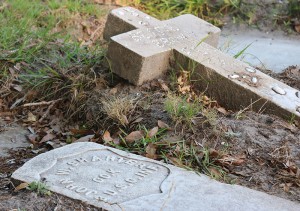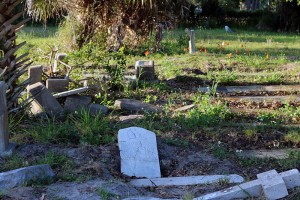
For four months, Vanessa Gray, 22, has methodically found forgotten burial vaults and headstones in Lincoln Cemetery.
By CAITLIN ASHWORTH
USFSP Reporter
GULFPORT – Birds chirped overhead and wind rustled the leaves of nearby trees as Vanessa Gray methodically dug through 6 inches of dirt and weeds.
Her shovel hit cement.
“Found it,” she said, then resumed digging.
Minutes later, she dropped the shovel and began wiping away the last bit of dirt to reveal the name and dates on the headstone of a long-forgotten grave at Lincoln Cemetery.
“This is my favorite part,” she said as she ran her fingers over the letters and numbers.
For four months, Gray, 22, has been uncovering gravesites at Lincoln Cemetery in Gulfport.
An estimated 6,000 African-Americans are buried in the graveyard, which covers 9 acres at 600 58th St. S between Boca Ciega High School to the south and Royal Palm Cemetery to the north.
When it was established in 1926, cemeteries were strictly segregated. So over the years, Lincoln became the resting place for veterans of the Civil War and two world wars, civil rights leaders, doctors and educators, and lots of ordinary folks.
But ground consecrated in solemn remembrance of so many people has become a symbol of shameful neglect.
For decades, as the cemetery changed hands several times, headstones broke apart and hundreds of graves disappeared beneath broken tree branches, weeds and porous sand.
Every couple of years, some person or group comes forward to lament the deplorable state of the cemetery and vows to seek improvements. Every few weeks, the city of Gulfport mows the tall grass and charges the cost to the cemetery’s out-of-state owner. City Manager Jim O’Reilly said the city is owed about $27,000 and has liens on the property.
But nothing much ever changes.
* * * * * * * * *

Gray uncovered the headstone of Civil War veteran John W. Sharter, who died in 1923.
Then Gray entered the picture.
Since December, she said, she has come to the cemetery almost every day after work as a server at a John’s Pass restaurant to spend two or three hours uncovering buried headstones and vaults.
Using the wire staffs of small orange flags, she methodically pokes the ground to feel for cement underneath, then marks each gravesite she discovers with a flag. Next, using a shovel and broom, she uncovers the headstone and grave.
Over time, she said, she has placed more than 400 orange flags throughout the cemetery, marking what she believes are headstones or vaults.
So why would a young white woman who never knew anybody who is buried there make an old African-American graveyard a personal project?
“It just needs to be done,” she said.
A Gulfport native, Gray said she has walked or driven past the cemetery countless times over the years and lamented its disgraceful condition.
As a third grader, she said, she and a friend would find trash bags scattered about that were full of flowers and other items that people had left on gravesites.
“We would put the flowers back on the graves,” she said.
In December, she was walking through the cemetery when some cement beneath the grass caught her eye. When she investigated, she found the burial vault of the Rev. David Purson, a minister and retired St. Petersburg city employee who died in 1968. That spurred her to hunt for more gravesites, a task that turned into a big project.
In the months that followed, Gray said, she has become so well acquainted with the cemetery that she knows the patterns of burial plots and the way that weeds and grass quickly cover them.
She is working now on the east side of the cemetery, alongside the Pinellas Trail. It was covered with dirt and grass, and many drivers who cut through the back of the cemetery drove over rows of graves without realizing it.

In some parts of the historic cemetery, headstones are piled in disarray.
Pieces of cement headstone are piled on the south side of the cemetery near the high school.
Gulfport police Sgt. Robert Burkhart comes by the cemetery often and checks up on Gray.
“I think what she’s doing is great,” he said.
Some of the oldest graves at Lincoln Cemetery were moved there years ago from Moffett Cemetery, the graveyard for blacks in the early days of St. Petersburg. Some were moved shortly after Lincoln opened in 1926, others when the Moffett site at 16th Street S and Fifth Avenue gave way to other uses in the late 1940s and 1950s.
Gray has found and uncovered some of those old graves, including one for John W. Sharter, one of three Civil War veterans who are buried in Lincoln.
* * * * * * * * *

While others stew, Gray digs away. “This just needs to be done,” she said.
The cemetery has been owned since 2009 by Sarlie McKinnon III, whose father and grandparents are buried there. But McKinnon lives out of state, and most of the more than $100,000 he received in state-required “perpetual care” funds to maintain the cemetery apparently has been spent.
McKinnon, who did not return several phone messages for this story, has proven difficult to reach. That has stymied people who have proposed that the cemetery be turned over to others who would provide better maintenance.
The city of Gulfport has looked into foreclosing on the cemetery and turning it over to the Gulfport Historical Society or another entity.
But Christine Brown, who is president of the Historical Society and a City Council member, said her group would need at least $1 million to maintain the cemetery in perpetuity.
Brown said that some of Gray’s work in the cemetery might be best left to professionals.
But Gray said waiting even longer is not an option. Many of the names on graves have worn off, she said, and some burial vaults have caved in and are beyond repair.
Gray said she has permission from the owner to work there, and she updates him once a month on her progress.
She has created a group on Facebook called Lincoln Cemetery Society that is organizing a cleanup on April 19.
“This needs to get done,” she said. “I’m just going to do it until it gets done.”
Then she resumed digging.
Caitlin Ashworth is a student reporter at the University of South Florida St. Petersburg.
Who’s buried in Lincoln Cemetery?
• An estimated 3,000 military veterans, including at least three who served in the Civil War.
• Chester James (died 1979), longtime community activist.
• Cleveland Johnson (died 1981), publisher of the Weekly Challenger newspaper.
• Elder Jordan (died 1936), former slave who became a prominent landowner and developer in the area around 22nd Street S.
• Edward McRae (died 1957), founder of a funeral home.
• Fannye Ayer Ponder (died 1982), stalwart in education and civic activism.
• Robert J. Swain (died 1974), dentist, businessman and civil rights activist.
• C. Bette Wimbish (died 2009), civil rights activist and first black elected to the St. Petersburg City Council.
• Ralph Wimbish (died 1967), physician and onetime president of the local NAACP.
